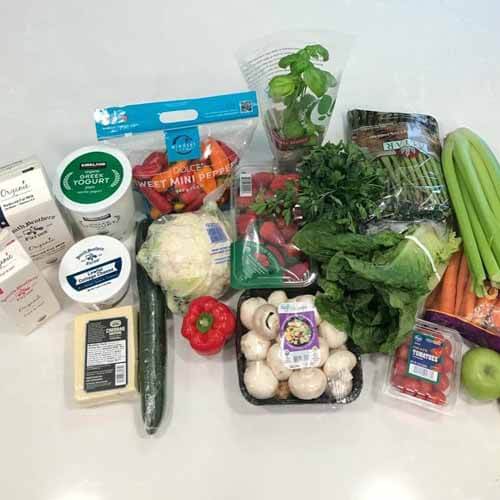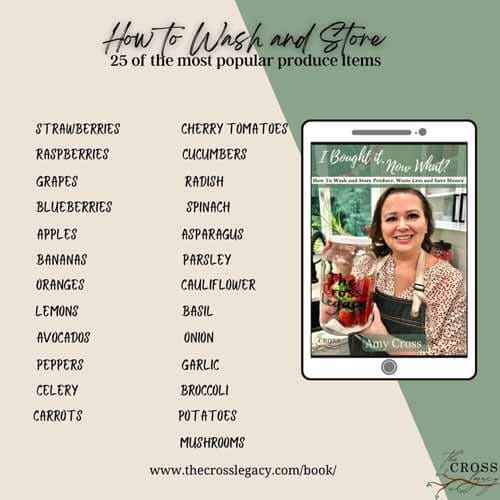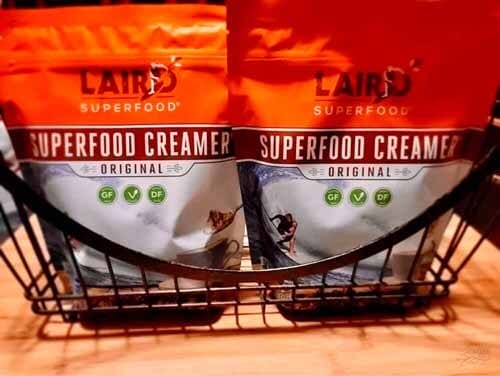DISCLOSURE: This post may contain affiliate links. Which means if you make a purchase through my links, I receive a small commission at no cost to you. For more information, please read my Disclaimer .

What keeps you running to the store most often?
Are you needing an item or a variety of ingredients for a meal?
Did you know that 23 of the 25 items in our new book will last a three-week grocery shopping cycle? Even the other two can be then put into the freezer and not tossed! Everything gets used.

This means with a little planning, you can have fresh fruits and veggies all three weeks!
We normally try to eat up the bananas by the end of the first week and save produce items that last longer like apples towards the end of the grocery shopping cycle. Raspberries will last on average for two weeks. All the other items in I Bought It, Now What will keep for the three-week cycle.
What Produce Will Last?
Let’s talk about the produce items that will last longer (3+ weeks).
What meals do you make with these fruits and vegetables? Could you prioritize your meals to eat the items that needed to be eaten first?
We did talk about two items that will not last. Bananas will not last three weeks. We eat bananas the first week and then freeze whatever is left for use in recipes and smoothies later on. (It helps to check the freezer so you don’t end up with eight bags of spinach… I might know this from experience.)
Grocery Shopping
How often do you run to the store and walk in through the produce section to end up buying items that you already have in the fridge at home?
When you are at the store, how much of your cart is an impulse buy? The “Oh this looks good” or “This sounds amazing” products that fall in the cart. Don’t forget the requests of the person who may be shopping with you.
We used to go to the store daily or would grab takeout until we took a good hard look at our budget. Finding a way to control the grocery budget was beyond helpful for my family.
Interested in stopping the vicious cycle of running by the store for milk today, bread tomorrow, and maybe a pepper, avocado and some cilantro on Tuesday? These skills will have you eating at home and enjoying the food you purchase. Hopefully, throwing away far less.
I have heard some say that the crisper drawer is where salad dreams go to die.
Is your salad dying in the drawer right now? I know before I tried some of these tips mine did.
Do you plan meals around what produce you have that needs to be used up?
What Changed?
Well, our mindset about how much we were wasting on food. By going to the store often we were getting excited with the new produce items and wanting to snack on them instead of the items we had bought the day or two before.
This was an endless cycle of food waste. I was shocked when I heard that the average American family throws out 30-40% of the food they buy. Then looking back over the years I realized how true that is.
How Do You Break the Cycle?
Switch to a three-week grocery shopping cycle. I have done this the last couple of years and found it works well for my family. But no matter what your starting point is, if you are going to the store multiple times a week to just once a week you will see a difference in how much you spend over the course of a month. Find what works for your family.
Plan Grocery Shopping
Here are some tips to help plan your grocery shop.
Before grocery shopping, check your pantry and freezer. Look for items you are low on. What do you have a lot of in your freezer? What needs to be eaten or rotated out of your pantry or freezer? Answering these questions will help you eat items before they go bad and need to be thrown away.
I keep an ongoing shopping list in a notebook and add anything I have missed. By taking a few minutes to check the pantry/freezer and look through them, I am reminded of the items that I might be forgetting about and how they can be used in the coming weeks.
One for Now, Two for Later
I am not sure if Jordan Page coined this phrase but it is definitely through her that I started learning this method of shopping. This might be a good time to check her out on YouTube and while you are over there subscribe to The Cross Legacy.
When I was starting to build my pantry this is how I did it. I utilized “1 for now, 2 for later.” Building a pantry has been helpful especially during the pandemic when it was scary to go out shopping.
Some shopping trips it was $5-$10 extra that I put aside for longer-term food storage. This was the easiest method to build my pantry.
If an item was on my grocery shopping list and it had a shelf life of at least a year, I would buy one for now and two for later. Three jars of peanut butter or extra ketchup. I use this method for staples or single ingredient items. This helps keep you out of the store later on when you just need one item. Often, that item will be in your fridge or freezer waiting to be used. What does your family go through? I just watch expiration dates and make sure I only buy what we would use in that time frame.
Be careful. I do not stock up on everything! Things I do not buy ahead are snacks, cereal, and chips. If the item is something that a group of hungry teens could demolish in an hour then these are not the kinds of things I stock up on.
Planning Your Pantry

Not everything is as simple as “buy 1 for now and 2 for later.” Some items need a different approach. I tried to rethink our milk/cream needs as we saw empty shelves and tried to plan ahead in case of an emergency. We are very lucky to live in an area where we get milk delivered to our house. Even with milk delivery I had added milk products to my pantry.
I normally keep at least a case of almond or alternative oat/hemp milk on hand; the shelf life of this is typically around a year. I keep liquid sweetened condensed milk in a can which can be mixed with almond milk and a little bit of vanilla for a coffee creamer substitute and also a powdered superfoods creamer. We always have extra cheese in the freezer.
Thinking Outside of the Box or Bread Bag

Costco has a great shelf-stable sourdough bread that comes in a box. I always have this on hand and it lasts six months on the shelf.
There are so many gluten-free bread options that also come like this now in grocery stores that are great to have just in case and last for months unopened.
When we have room in our freezer I also try to make sure we have a couple extra loaves in there, as long as they are being used in the next three months you don’t have to worry about frost issues. Again, check your freezers and pantry before shopping.
By figuring out those things that send your family running to the store often and what you can do to stock up on, it helps your overall budget.
How to Avoid the Extras in Your Cart
I don’t know about you but I can’t even walk into the store without spending $50 on mindless things that weren’t even on my list. Then, if I am at the store tired and hungry, my shopping cart will look very different.
By following the “buy 1 for now, 2 for later” method and the cleaning and storage tips in my book I Bought It, Now What? I have been able to shop on a three week cycle. This three-week cycle limits all the extras that are bought. If you are not at the store, then the little added things don’t fall in your cart.
Wrapping Things Up
Going to the store less will help your budget. Go from multiple times a week to once a week. Go from weekly to biweekly. Try the three-week cycle and see how it works.
Start a solid list of items you use. Have extras on hand of your most used items.
Buy a variety of produce. Come home and clean it and store it the #strawberriesinajar way. I Bought it, Now What? will show you the top 25 fruits and veggies to get you through the three-week cycle.
Plan your meals by what you have in your house. What is looking like it needs to be eaten now? Then eat it now. Should you freeze it for later?
Check your crisper drawer. If that is where salad dreams go to die, then make sure your salad isn’t dying right now.
What tips are you going to try?
What item or items will be on your “Buy 1 now, and 2 for Later” on your next trip?


Leave a Comment